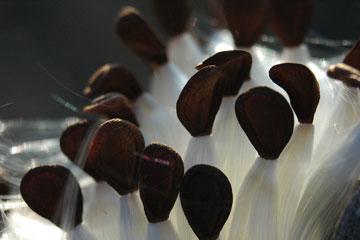 by Preston MacDougall February 03, 2007
If you were in Times Square in New York City on Mole Day last year - that's October 23rd for any non-chemists - then you might have noticed a series of geekish visual vignettes on the Jumbotron. In this 15-second video, that ran several times each hour over a two-week period, everyone is wearing plastic safety goggles. That's the only thing that makes it geekish. That and the requisite pose of holding up a flask, containing a colored liquid, and staring at it as though it was a van Gogh.
The video was produced by the American Chemical Society, and it featured several Project SEED scholars, with their volunteer mentors, engaged in laboratory research. Subtitles informed onlookers that these students might have been searching for new medicines or clean sources of energy, or perhaps developing tools for forensic science or homeland security. The take-home message was "Make a difference be a chemist." Project SEED is a summer research program for economically disadvantaged high school students, that was begun by members of the American Chemical Society in 1968. It has been financially supported by corporations and individual members of the ACS. Hundreds of mentors, from academic as well as industrial research labs, volunteer their time and bench space to these hopeful youth. College scholarships are offered to the SEED scholars who show the most promise for making a difference in the science that is all about changing things. Who knows, one of them may go on to be the next Percy Julian. Who is Percy Julian? The short answer is that he was a scientific genius. I could expand on this, coloring in details about his African-American heritage (his grandfather was a slave), or his academic success in natural products chemistry (he obtained graduate degrees from both Harvard and the University of Vienna - which are like Mecca and Medina to organic chemists). That would just be the beginning, however. In a short commentary, I would have to be very selective in describing his profound impacts on industrial chemistry. The numerous patents that he received, first in the Soya Division of Glidden (the Chicago paint and chemical company), then later in his own company, Julian Laboratories, ranged from the first commercially viable synthesis of cortisone, to fire-extinguishing foams that saved countless lives during World War II. The cortisone might have come in handy for the arthritis sufferers among the university, municipal, and industrial policy makers who would have reason to wring their hands over their involvement in the numerous forms of racial discrimination that Percy Julian experienced. For instance, after he obtained his doctorate in Vienna, he was denied a professorship at his alma mater, DePauw University, even though he had been the valedictorian in his class. It is said that Percy Julian broke the color-barrier in American science more than a decade before Jackie Robinson did it in baseball. That was a half-page biographical sketch of a chemical genius. You may have a postage stamp-size one already. In 1990, as part of their Black Heritage series, the U.S. Postal Service issued a first-class postage stamp honoring Percy Lavon Julian. In this handsome stamp, he is doubly rendered. In the foreground, he is a youthful white-coated research scientist (without the geeky goggles), and looming large in the background, he is a gray-templed businessman who transformed a chemical industry. I am sorry to say that the most honest answer that I can give you to the question "Who is Percy Julian?" is that I really don't know the whole story. But, thanks to PBS, and Stephen Lyons (an independent documentary producer), I have a plan to fix that. The honest, and two-hour long answer, will be given Tuesday, February 6, on NOVA. This biographical program is titled "Forgotten Genius". It airs at 7 pm in Nashville, but check your local listings. If you miss it, you can watch the complete show online at www.pbs.org. If you can, I encourage you to watch it with young people who are considering careers in science. Since chemistry impacts all of our lives in so many ways, the question "what can brown do for chemistry", really amounts to "what can brown do for you?" Among many possible benefits,
I hope the program leads to expansion of Project SEED. However,
based on the most common complaint that I hear in freshman chemistry
lab, the best recruiting tool might simply be commercially viable,
OSHA-approved safety goggles by Oakley.
Publish A Letter on SitNews Read Letters/Opinions Submit A Letter to the Editor
|
||
